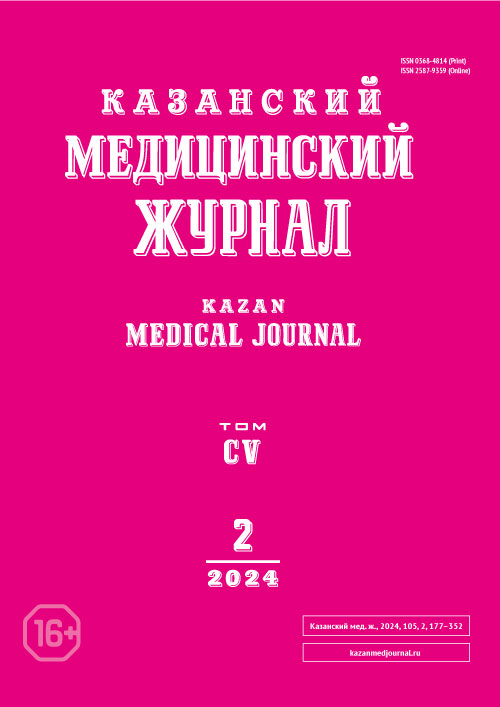Dynamics of structural transformations of intervertebral discs in humans in the fetal period
- Authors: Vikhareva L.V.1, Makarova V.V.2,3
-
Affiliations:
- Tyumen State Medical University
- Medical and sanitary unit of the Ministry of Internal Affairs of Russia for the Chelyabinsk region
- South Ural State Medical University
- Issue: Vol 105, No 2 (2024)
- Pages: 214-221
- Section: Theoretical and clinical medicine
- Submitted: 12.09.2023
- Accepted: 21.12.2023
- Published: 01.04.2024
- URL: https://kazanmedjournal.ru/kazanmedj/article/view/569344
- DOI: https://doi.org/10.17816/KMJ569344
- ID: 569344
Cite item
Abstract
BACKGROUND: The process of formation of the intervertebral disc structure remains poorly understood. Therefore, evaluating the forecasts for the development of the disc’s fibrous component as the foundation of its strength and elastic properties in the postnatal period seems appropriate.
AIM: To identify microstructural transformations of the annulus fibrosus and nucleus pulposus in the fetal period and compare them with the ontogenetic orientation of the spinal motion segment.
MATERIAL AND METHODS: The study material included 150 intervertebral discs obtained during autopsy of 50 fetuses. The gestational age of 42 fetuses was in the early fetal period, 8 fetuses were in the late fetal period. Intervertebral discs СV–СVI, ThV–ThVI, LV–SI were examined in each fetus. All histological preparations were stained with hematoxylin and eosin, silver impregnation method, PAS reaction, Alcian blue (pH=1.0), Van Gieson and Weigert stains. For intergroup comparisons, the Kruskal–Wallis, Mann–Whitney, and Newman–Keuls tests were used. Differences were considered statistically significant at p ≤0.05.
RESULTS: Elastic fibers in the late fetal period were found in the annulus fibrosus and the peripheral zone of the nucleus pulposus. The intensity of staining of collagen and elastic fibers was more pronounced in the outer layers of the annulus fibrosus. Analysis of the parameters of the vascular-connective tissue formations showed an increase in their number (p=0.0368) and an increase in the number of vessels in the vascular-connective tissue formations of the intervertebral disc (p=0.0449) in the direction of the lower levels of the spinal motion segments. Differences in these two indicators were obtained between the СV–СVI and LV–SI discs, as well as between the СV–СVI and ThV–ThVI discs. In relation to all the studied morphometric parameters of the vascular-connective tissue formations in the cervical and thoracic spine, no statistically significant differences were obtained between the early and late fetal periods.
CONCLUSION: The development of the intervertebral disc occurs from the peripheral parts to the center; the source for its further development is the fibrous ring.
Full Text
About the authors
Larisa V. Vikhareva
Tyumen State Medical University
Author for correspondence.
Email: vikharevalv@yandex.ru
ORCID iD: 0000-0001-6864-4417
SPIN-code: 8574-1589
M.D., D. Sci. (Med.), Prof., Head of Depart., Depart. Of Topographical Anatomy and Operative Surgery
Russian Federation, TyumenViktoriya V. Makarova
Medical and sanitary unit of the Ministry of Internal Affairs of Russia for the Chelyabinsk region; South Ural State Medical University
Email: makarova.nadezhdachel@mail.ru
ORCID iD: 0000-0003-1823-3163
SPIN-code: 2974-7620
M.D., Assistant, Depart. of Anatomy and Operative Surgery
Russian Federation, Chelyabinsk; ChelyabinskReferences
- Frost BA, Camarero-Espinosa S, Foster EJ. Materials for the spine: Anatomy, problems, and solutions. Materials (Basel). 2019;12(2):253. doi: 10.3390/ma12020253.
- Popelyanskiy YaYu. Ortropedicheskaya nevrologiya (vertebronevrologiya). Rukovodstvo dlya vrachey. (Orthopedic neurology (vertebroneurology). Guidelines for doctors.) M.: MEDpress-inform; 2011. 672 p. (In Russ.)
- Sak NN, Peculiarities and variants of the structure of lumbar intervertebral discs in humans. Arkhiv anatomii, gistologii i embriologii. 1991;100(1):74–85. (In Russ.)
- Baptista JS, Traynelis VC, Liberti EA, Fontes RBV. Expression of degenerative markers in intervertebral discs of young and elderly asymptomatic individuals. PLoS One. 2020;(1):e0228155. doi: 10.1371/journal.pone.0228155.
- Bian Q, Ma L, Jain A, Crane JL, Kebaish K, Wan M, Zhang Z, Edward Guo X, Sponseller PD, Seguin CA, Riley LH, Wang Y, Cao X. Mechanosignaling activation of TGF-β maintains intervertebral disc homeostasis. Bone Res. 2017;5:17008. doi: 10.1038/boneres.2017.8.
- Chen C, Zhou T, Sun X, Han C, Zhang K, Zhao C, Li X, Tian H, Yang X, Zhou Y, Chen Z, Qin A, Zhao J. Autologous fibroblasts induce fibrosis of the nucleus pulposus to maintain the stability of degenerative intervertebral discs. Bone Res. 2020;8:7. doi: 10.1038/s41413-019-0082-7.
- Feng Y, Egan B, Wang J. Genetic factors in intervertebral disc degeneration. Genes Dis. 2016;3(3):178–185. doi: 10.1016/j.gendis.2016.04.005.
- Fontes RBV, Baptista JS, Rabbani SR, Traynelis VC, Liberti EA. Structural and ultrastructural analysis of the cervical discs of young and elderly humans. PLoS One. 2015;10(10):e0139283. doi: 10.1371/journal.pone.0139283.
- Casaroli G, Villa T, Bassani T, Berger-Roscher N, Wilke HJ, Galbusera F. Numerical prediction of the mechanical failure of the intervertebral disc under complex loading conditions. Materials (Basel). 2017;10(1):31. doi: 10.3390/ma10010031.
- Chan SCW, Ferguson SJ, Gantenbein-Ritter B. The effects of dynamic loading on the intervertebral disc. Eur Spine J. 2011;20(11):1796–1812. doi: 10.1007/s00586-011-1827-1.
- Dowdell J, Erwin M, Choma T, Vaccaro A, Iatridis J, Cho SK. Intervertebral disk degeneration and repair. Neurosurgery. 2017;80(3):S46–S54. doi: 10.1093/neuros/nyw078.
- Kapandzhi AI. Pozvonochnik: fiziologiya sustavov. (Spine: physiology of joints.) Kishinevskiy EV, translator. M.: Izdatel'stvo “E”; 2007. 344 p. (In Russ.)
- Omel'yanenko NP, Slutskiy LI. Soedinitel'naya tkan' (gistofiziologiya i biokhimiya). (Connective tissue (histophysiology and biochemistry.) SP Prokhorova, editor. Vol. 1. M: Izvestiya; 2009. 380 p. (In Russ.)
- Pavlova VN, Kop'eva TN, Sluckij LI, Pavlov GG. Hryashch. (Cartilage.) M.: Meditsina; 1988. 320 p. (In Russ.)
- Cortes DH, Han WM, Smith LJ, Elliott DM. Mechanical properties of the extra-fibrillar matrix of human annulus fibrosus are location and age dependent. J Orthop Res. 2013;31(11):1725–1732. doi: 10.1002/jor.22430.
Supplementary files










